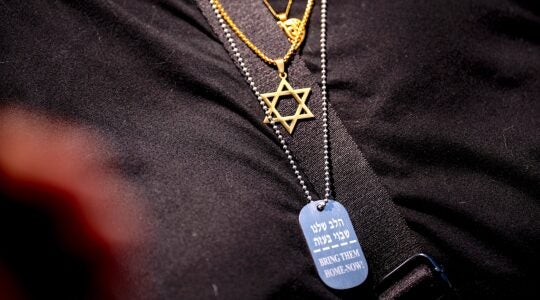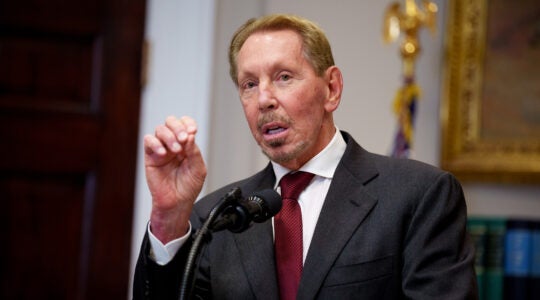
New York Times columnist Maureen Dowd does some JTA Archive digging in her latest column, a primer on the Mormon faith.
[[READMORE]]
The impetus for Dowd’s piece is the great public curiosity with the faith of former Massachussetts governor and presidential candidate Mitt Romney. Prominent atheist Christopher Hitchens has many issues with the Church of Latter-Day Saints, including the church’s practice of posthumous baptism. Dowd references a 1995 JTA article about Mormon-Jewish tension written by Debra Nussbaum Cohen (and revisited by Chanan Tigay in 2005). Writes Dowd:
The Mormons even baptized Anne Frank.
It took Ernest Michel, then chairman of the American Gathering of Jewish Holocaust Survivors, three years to get Mormons to agree to stop proxy-baptizing Holocaust victims.
Mormons desisted in 1995 after Michel, as the Jewish Telegraphic Agency reported, “discovered that his own mother, father, grandmother and best childhood friend, all from Mannheim, Germany, had been posthumously baptized.”
Michel told the news agency that “I was hurt that my parents, who were killed as Jews in Auschwitz, were being listed as members of the Mormon faith.”
During the previous presidential campaign trail four years ago, faith was also in the national spot light, owing largely to Romney. In June 2007, the National Jewish Democratic Council defended the Republican candidate by dismissing criticism based on his faith. On Oct. 19 that year, a JTA brief noted a Newsweek Magazine interview in which Romney answered affirmatively when asked whether he has participated in posthumous baptisms. In December, Fox News analyst Susan Estrich wrote an opinion piece in support of Romney’s openness about his faith and suggested that Jews in particular should be sensitive to the matter.
At the time, e-mail rumors about Senator Barack Obama being a Muslim were causing even greater alarm among Jewish voters, prompting an e-mail response from several major Jewish organizations. As Capital J blogger Ron Kampeas reported:
In e-mail exchanges, Jewish organizational leaders considered expanding its message to address knocks on Romney’s Mormon faith.
Ultimately, those involved said, It was felt that it would be more effective to narrowly address the Obama issue because that was the only smear campaign focusing on Jewish interest.
The letter did address the deterioration in the political discourse.
"Attempts of this sort to mislead and inflame voters should not be part of our political discourse and should be rebuffed by all who believe in our democracy," it said. "Jewish voters, like all voters, should support whichever candidate they believe would make the best president. We urge everyone to make that decision based on the factual records of these candidates, and nothing less."
While it may be tough to put the posthumous baptism issue to rest, it’s worth mentioning that 95 years ago, the tables were turned. Julie Wiener’s 2002 feature article about the Jews of Utah leads, "On the campaign trail in 1916, Simon Bamberger, who was elected the state’s first and only Jewish governor, had to argue his way into a meeting hall by saying, ‘As a Jew I’ve been called many a bad name, but this is the first time in my life that I’ve been called a damned gentile.’"
The context of the gentile remark was explained in a ‘Comparative Religion 101’ of sorts printed in the Feb. 21, 1928 issue of the Jewish Daily Bulletin. In addition to comparing Jews and Mormons and discussing intermarriage in Utah, the article also noted the campaign strategy utilized by Bamberger’s supporters:
Governor Bamberger, now deceased, was nominated by Hon. B. H. Roberts, until recently head of the Eastern States Mission of the Mormon Church and one of its most able men. Roberts told the writer in talking on the subject that he deliberately took up the question of his candidate’s race because he knew it would come up in some quarters sooner or later, and during the campaign he was among his most ardent supporters.
Following Bamberger’s death on Oct. 10, 1926, JTA’s obituary, a eulogy by Mormon leader Heber J. Grant, and the rise of Bamberger’s son and other Jewish political leaders in Salt Lake City all demonstrated that back in the day, at least, a Jew was electable in Utah.
ARCHIVE NOTES: In Jewish genealogy circles today, Mormons are known for their meticulous record-keeping. Nevertheless, one claim about family ties may be met with skepticism: Mormon leader Andrew Ivins declared in 1924 that Hawaiians were decendants of Jews … The Archive is missing JTA Daily Bulletin articles from 1917-1923. But the Library of Congress’s "Chronicling America" archive shows that the Jewish Telegraphic Agency had a Utah-based client in the Ogden Standard Examiner as early as 1920. With Ogden located 40 miles north of Salt Lake City, it’s conceivable that Bamberger’s political ascendancy may have helped make this Jewish News shidduch … Best JTA headline from Utah ever?
Image: Former Governor Mitt Romney of Massachusetts speaking at CPAC 2011 in Washington, D.C. Gage Skidmore, Feb. 11, 2011 (CC BY-SA 2.0)
JTA has documented Jewish history in real-time for over a century. Keep our journalism strong by joining us in supporting independent, award-winning reporting.





